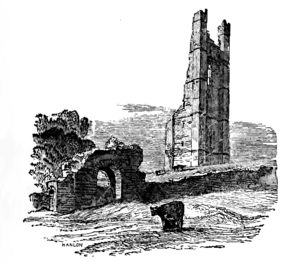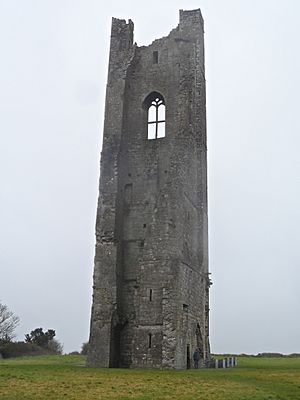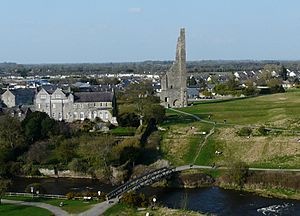St. Mary's Abbey, Trim facts for kids

St. Mary's Abbey was an important religious building in Trim, County Meath, Ireland. It was home to a group of monks called Augustinian canons. The abbey was dedicated to the Virgin Mary. It stood on the north side of the River Boyne, right across from Trim Castle. Many people believed St. Patrick himself founded the abbey. It became a very popular place for pilgrims, who came to see a special statue of the Virgin Mary. People thought this statue had healing powers. However, King Henry VIII closed the abbey during the Reformation. Today, only the Yellow Steeple remains. This is the ruined bell tower, named for its yellow color in the sunset. Another building, Talbot's Castle, was once part of the abbey too.
Contents
History of St. Mary's Abbey
According to old stories, St. Patrick started a church in Trim. This church was attacked and burned down at least twice, in 1108 and 1127. During these attacks, people who sought safety inside the church were tragically burned when it was set on fire.
Rebuilding and Growth
After these fires, the church was rebuilt as an Augustinian abbey in the 1100s. It was dedicated to St. Mary. The abbey also served as the local parish church for the community. Between 1140 and 1148, St. Malachy introduced a special set of rules for the Augustinian monks there. The de Lacy family was also connected to the abbey in the 1200s.
The church burned again in 1368. Soon after this fire, the abbey created a statue of the Virgin Mary. This statue became famous for performing healing miracles. It grew to be the most celebrated shrine to Mary in all of Ireland. Many pilgrims traveled to see it.
Royal Support and Miracles
In 1402, King Henry IV offered protection to pilgrims visiting the abbey. This included Irish rebels, showing how important the shrine was. King Henry V continued this protection. In 1472, a special law was passed in Naas. This law gave the abbey land and two watermills. This money was to pay for a candle to burn forever at the statue. It also funded four candles during special masses for St. Mary.
The law also confirmed a gift from Richard, Duke of York. He gave the abbey fifty-one acres of land. It also promised safety for all pilgrims. Medieval Irish stories say the statue performed many healing miracles around the 1400s. Because of these miracles, some people even called Trim the "Lourdes of Ireland."
Closure of the Abbey
Royal support for the abbey changed during the religious reforms under King Henry VIII. This period was known as the dissolution of the monasteries. Because the statue was so famous, Archbishop Browne was hesitant to destroy it. However, the statue was publicly burned in 1538. One story says the badly burned statue survived and was kept by a Catholic family in private.
The abbey itself did not last much longer. On May 15, 1542, King Henry VIII's agents forced Geoffry Dardice, the last abbot of St. Mary's, to sign papers closing the abbey. About a month later, the abbot received a yearly payment of £15. The king took all the abbey's wealth, which was a very large sum of money. Sir Anthony St. Leger received the abbey's lands.
The Yellow Steeple's Story
Local stories say that the Yellow Steeple was destroyed by Oliver Cromwell. One account suggests the Yellow Steeple was used as a fort against Cromwell's soldiers. The tower was then destroyed during the fighting.
What Remains Today
The Yellow Steeple is the most noticeable part of the abbey that still stands. It is about 40 meters (131 feet) tall, even though it is a ruin. People believe the tower was built soon after the 1368 fire. However, some also suggest it was built around 1450 under Richard, Duke of York.
The Yellow Steeple
The tower was made from carefully cut limestone. It served as the abbey's bell tower. You can still see parts of a spiral staircase inside. The eastern wall of the tower rises seven stories high. The southern wall reaches five stories. Not much is left of the other sides of what was once a square tower. The eastern wall still has two strong corner supports called buttresses.
The walls are mostly plain, with a few windows and simple decorations. The most detailed part is a double-pointed window where the bells would have been. It has a flower-like pattern above it. The south wall is partly built from rough stones. This suggests it might have been an inner wall. There are also signs that a tall, pointed object, perhaps a monument, was once connected to this south wall. The abbey church was likely connected to the tower from the south side.
Talbot's Castle
While the Yellow Steeple is often seen as the only remaining part of the abbey, some clues suggest that Talbot's Castle, a nearby manor house, might have been the abbey's dining hall, or refectory. Its size, shape, and features inside suggest it was a monastic building. It was later changed into a private home.



